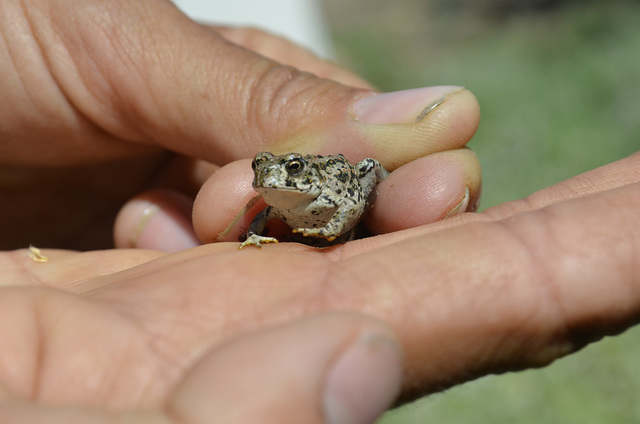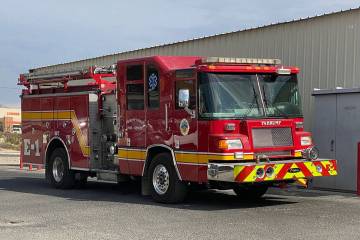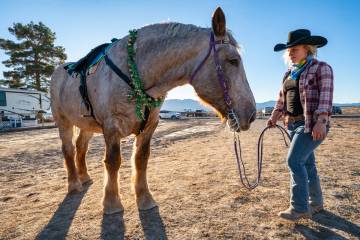Solar projects’ raise wildlife concern
Editors Note: This is the first half of a two-part article. The second half will run in Fridays edition.
Hundreds of cars and trucks zoom past a quiet six-acre ranch just off the U.S. Highway 95 just north of Beatty.
Since moving to Beatty in 2002, Laura Cunningham and Kevin Emmerich, two retired biologists, have done an animal habitat restoration on their secluded property. A bare dirt place in the middle of the desert soon attracted the endangered Amargosa toad and various birds that come to nest in the surrounding shrubs. Cunningham compares her homemade wildlife habitat to an oasis.
Our main goal is to preserve this desert because we really love it, she said.
But on a recent 115-degree day in Beatty, Cunningham, a former Death Valley National Park ranger, said she is worried about the rapid expansion of renewable energy projects in the desert.
We support green energy, but we also need to realize, every form of energy has impacts to the environment, she said.
In 2008, Cunningham and Emmerich co-founded the Basin and Range Watch, a nonprofit dedicated to conservation of the deserts in Nevada and California.
Our group is basically trying to educate people to say, Yes, climate change is important but so is the desert ecosystems and lets try to plan all of this better where we site these projects, Cunningham said.
The group advocates for renewable energy alternatives to utility-scale solar and wind projects that are constructed on desert ecosystems. The nonprofit suggests putting renewable energy projects on already disturbed lands and on rooftops in urban areas such as Las Vegas.
In her backyard, not far from the pond that she dug out with Emmerich, Cunningham showed dozens of Amargosa toads, the endangered species that is endemic to the Oasis Valley, a small area in the Amargosa Desert.
The Amargosa Desert, that spans 2,600 square miles along the Nevada-California border, boasts a diverse array of species, some of them endangered. There are desert tortoise, golden eagles and pupfish, endemic species that live in the saline Amargosa River that runs its course through the Amargosa Desert.
Cunningham is worried these animals could be threatened if the expansion of the utilities projects in the desert continues.
A lot of people drive through here and say, Oh, this is just ugly, boring flatland. And so, we are trying to say, No, theres toads and eagles and tortoises and interesting lizards and little oasis like this, she said.
Sunshine Valley solar project
In neighboring Amargosa Valley, the Sunshine Valley solar project, the biggest commercial development in the area in years, is gaining ground.
Officials in Amargosa Valley are hoping to reap economic benefits from the project that will be constructed by First Solar, an Arizona-based solar panel manufacturing company.
The Basin and Range Watch, meanwhile, is concerned that the 745-acre development, located eight miles away from Ash Meadows National Wildlife Refuge, may take a toll on endangered species such as desert tortoise and the Yuma clapper rail.
Laura Abram, director for public affairs at First Solar, said the environmental review for the Sunshine Valley solar project found sparse Mojave Desert scrub habitat, a few burrowing owl burrows, and insignificant cultural resources in the area where it plans to construct the project.
First Solar has consulted with the U.S. Fish and Wildlife Service and Nevada Department of Wildlife with respect to the potential for effects on eagles, desert tortoise and burrowing owl, and the agencies have acknowledged that impacts to these species will be very minimal, Abram said.
When fully operational, the photovoltaic project will generate solar energy for about 23,000 Nevada homes per year, displacing approximately 178,000 metric tons of carbon dioxide annually, the equivalent of taking about 26,000 cars off the road, officials said.
Photovoltaic power plants consist of rows of solar panels mounted on structures angled for maximum exposure to sunlight.
Unlike solar projects that reflect light, photovoltaic plants absorb it. The potential attraction to photovoltaic arrays by water-dependent species, which is sometimes referred to as the lake effect, has not been scientifically substantiated, nor has it been consistently observed or documented at photovoltaic solar projects, officials said.
Abram said that theres no credible evidence to indicate that solar facilities pose a threat to bird populations. More information is needed to better evaluate the concerns that have been raised regarding bird mortality at photovoltaic projects, she added.
The solar industry is devoting substantial resources and collaborating with environmental groups and governmental agencies to better understand whether solar facilities have a measurable impact on bird populations, Abram said. However, data collected at solar facilities to date does not indicate that solar projects are a significant source, or even a direct cause, of avian mortality.
Amargosa Valley officials have welcomed the Sunshine Valley solar project, letting First Solar lease a large swath of land for its development, but Cunningham and Emmerich further argue that Nye County may have been too open to massive development projects.
Sometimes, they dont listen to the local communities who may not want a gigantic industrialization of Amargosa Valley, Cunningham said.
Contact reporter Daria Sokolova at dsokolova@pvtimes.com. On Twitter: @dariasokolova77

















